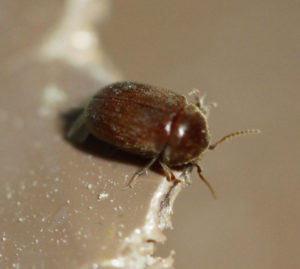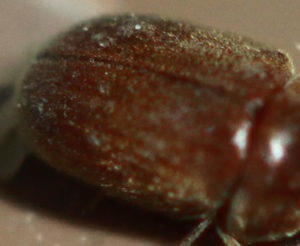 (Lasioderma serricorne)
(Lasioderma serricorne)
Cigarette beetles are the most common pantry pest found in Texas. They feed on several types of plant material, including beans, flour, grains, nuts, seeds, spices, tobacco, potpourri, cottonseed meal, dried flower arrangements, and dried fruits and vegetables. Cigarette beetles are commonly confused with drugstore beetles.
Characteristics
Adults

Figure 1. Cigarette beetle wing cover

Figure 2. Cigarette beetle head concealment
The adult beetles are:
- Oval shaped
- Light-brown in color
- 1/16 to 1/8 inch long
- Head concealed by a hood-like prothorax when viewed from above
- Wing covers are very smooth
- Segments of the antennae are saw-like
Larvae

Figure 3. Cigarette beetle antennae segments

Figure 4. Cigarette beetle larvae
Mature larvae can grow to be up to 3/16 inches long. Their bodies are white and C-shaped. All of the body segments are similar in size. Cigarette beetle larvae are covered with fine hair more noticeable than those found on the drugstore beetle larvae.
Biology
Between 6-20 days a female cigarette beetle can lay up to 100 eggs. She will lay them in crevices, folds, or depressions in the food source. The amount of time for the beetles to complete their development depends on the type of food source and the environmental conditions. It can take them anywhere from 26 to 100 days. For optimum development they need a relative humidity between 70-80% and temperature between 68° and 86°F. Their development will stop if the temperature gets below 59° and above 94°F.
The number of larvae instars range from four to six. After hatching, the larvae are very active and can enter packaging material through very small holes. When ready to pupate, the larvae will construct pupae cells within the food source. Cigarette beetle adults are very good fliers.
